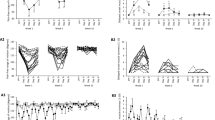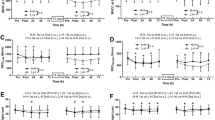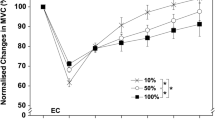Abstract
Purpose
Low-intensity eccentric contractions with a load corresponding to 10% of maximal voluntary isometric contraction strength (10% EC) attenuate muscle damage in a subsequent bout of higher-intensity eccentric contractions performed within 2 weeks for the elbow flexors, knee flexors and knee extensors. However, it is not known whether this strategy could be applied to other muscles. This study investigated whether 10% EC would confer damage protective effect on high-intensity eccentric contractions (80% EC) for nine different muscle groups.
Methods
Untrained young men were placed to an experimental or a control group (n = 12/group). Experimental group performed 50 eccentric contractions with a load corresponding to 10% EC at 2 days prior to 50 eccentric contractions with 80% EC for the elbow flexors and extensors, pectoralis, knee flexors and extensors, plantar flexors, latissimus, abdominis and erector spinae. Control group performed 80% EC without 10% EC. Changes in maximal voluntary isometric contraction strength (MVC) and muscle soreness, plasma creatine kinase (CK) activity and myoglobin concentration after 80% EC were compared between groups by a mixed-factor ANOVA.
Results
MVC recovered faster (e.g., 6–31% greater MVC at 5 days post-exercise), and peak muscle soreness was 36–54% lower for Experimental than Control group for the nine muscles (P < 0.05). Increases in plasma CK activity and myoglobin concentration were smaller for Experimental (e.g., peak CK: 2763 ± 3459 IU/L) than Control group (120,360 ± 50,158 IU/L).
Conclusions
These results showed that 10% EC was effective for attenuating the magnitude of muscle damage after 80% EC for all muscles, although the magnitude of the protective effect differed among the muscles.




Similar content being viewed by others

Data availability
The data of the current study are available from the corresponding author on reasonable request.
Abbreviations
- ANOVA:
-
Analysis of variance
- CK:
-
Creatine kinase
- CV:
-
Coefficient of variation
- DOMS:
-
Delayed-onset muscle soreness
- EC:
-
Eccentric contractions
- ECM:
-
Extracellular matrix
- MVC:
-
Maximal voluntary isometric contraction
- R:
-
Intraclass correlation coefficient
- SD:
-
Standard deviation
References
American College of Sports Medicine (2009) American College of Sports Medicine position stand. Progression models in resistance training for healthy adults. Med Sci Sports Exerc 41:687–708
Bakeman R (2000) Recommended effect size statistics for repeated measures designs. Behav Res Methods 37:379–384
Beetham R (2000) Biochemical investigation of suspected rhabdomyolysis. Ann Clin Biochem 37:581–587
Chen TC, Lin KY, Chen HL et al (2011) Comparison in eccentric exercise–induced muscle damage among four limb muscles. Eur J Appl Physiol 111:211–223
Chen HL, Nosaka K, Chen TC (2012) Muscle damage protection by low-intensity eccentric contractions remains for 2 weeks but not 3 weeks. Eur J Appl Physiol 112:555–565
Chen TC, Tseng WC, Huang GL et al (2013) Low-intensity eccentric contractions attenuate muscle damage induced by subsequent maximal eccentric exercise of the knee extensors in the elderly. Eur J Appl Physiol 113:1005–1015
Chen TC, Chen HL, Liu YC et al (2014) Eccentric exercise-induced muscle damage of pre-adolescent and adolescent boys in comparison to young men. Eur J Appl Physiol 114:1183–1195
Chen HY, Wang HS, Tung K et al (2015) Effects of gender difference and caffeine supplementation on anaerobic muscle performance. Int J Sports Med 36:974–978
Chen TC, Chen HL, Lin MJ et al (2016) Contralateral repeated bout effect of eccentric exercise of the elbow flexors. Med Sci Sports Exerc 48:2030–2039
Chen TC, Hsieh CC, Tseng KW, Nosaka K (2017a) Effects of descending stair walking on health and fitness of elderly obese women. Med Sci Sports Exerc 49:1614–1622
Chen TC, Tseng WC, Huang GL et al (2017b) Superior effects of eccentric to concentric knee extensor resistance training on physical fitness, insulin sensitivity and lipid profiles of elderly men. Front Physiol 8:209
Chen TC, Lin MJ, Chen HL et al (2018a) Contralateral repeated bout effect of the knee flexors. Med Sci Sports Exerc 50:542–550
Chen TC, Lin MJ, Chen HL et al (2018b) Low-intensity elbow flexion eccentric contractions attenuate maximal eccentric exercise-induced muscle damage of the contralateral arm. J Sci Med Sports 21:1068–1072
Chung P, Liu C, Wang H et al (2017) Various performance-enhancing effects from the same intensity of whole-body vibration training. J Sport Health Sci 6:333–339
Cohen J (1988) Statistical power analysis for the behavioral sciences, 2nd edn. Lawrence Erlbaum Associates, Hillsdale
Hubal MJ, Devaney JM, Hoffman EP et al (2010) CCL2 and CCR2 polymorphisms are associated with markers of exercise-induced skeletal muscle damage. J Appl Physiol (1985) 108:1651–1658
Hyldahl RD, Hubal MJ (2014) Lengthening our perspective: morphological, cellular, and molecular responses to eccentric exercise. Muscle Nerve 49:155–170
Hyldahl RD, Chen TC, Nosaka K (2017) Mechanisms and mediators of the skeletal muscle repeated bout effect. Exerc Sport Sci Rev 45:24–33
Jamurtas AZ, Theocharis V, Tofas T et al (2005) Comparison between leg and arm eccentric exercises of the same relative intensity on indices of muscle damage. Eur J Appl Physiol 95:179–185
Lin MJ, Chen TC, Chen HL et al (2015) Low-intensity eccentric contractions of the knee extensors and flexors protect against muscle damage. Appl Physiol Nutr Metab 40:1004–1011
Lin MJ, Nosaka K, Ho CC et al (2018) Influence of maturation status on eccentric exercise-induced muscle damage and the repeated bout effect in females. Front Physiol 8:1118
Nelson AG, Kokkonen J (2014) Stretching anatomy. Human Kinetics, Champaign, Illinois
O’Connor FG, Brennan FH Jr, Campbell W et al (2008) Return to physical activity after exertional rhabdomyolysis. Curr Sports Med Rep 7:328–331
Paschalis V, Nikolaidis MG, Theodorou AA et al (2010) Eccentric exercise affects the upper limbs more than the lower limbs in position sense and reaction angle. J Sports Sci 28:33–43
Paschalis V, Nikolaidis MG, Theodorou G et al (2011) A weekly bout of eccentric exercise is sufficient to induce health-promoting effects. Med Sci Sports Exerc 43:64–73
Rawson ES, Clarkson PM, Tarnopolsky MA (2017) Perspectives on exertional rhabdomyolysis. Sports Med 47:33–49
Shih Y, Chen YC, Lee YS et al (2016) Walking beyond preferred transition speed increases muscle activations with a shift from inverted pendulum to spring mass model in lower extremity. Gait Posture 46:5–10
Tseng KW, Tseng WC, Lin MJ et al (2016) Protective effect by maximal isometric contractions against maximal eccentric exercise-induced muscle damage of the knee extensors. Res Sports Med 24:228–241
Tsuchiya Y, Nakazato K, Ochi E (2018) Contralateral repeated bout effect after eccentric exercise on muscular activation. Eur J Appl Physiol 118:1997–2005
Wang HH, Chen WH, Liu C et al (2014) Whole-body vibration combined with extra-load training for enhancing the strength and speed of track and field athletes. J Strength Cond Res 28:2470–2477
Yamada R, Himori K, Tatebayashi D et al (2018) Preconditioning contractions prevent the delayed onset of myofibrillar dysfunction after damaging eccentric contractions. J Physiol 596:4427–4442
Acknowledgements
The authors thank Mr. Yu-Chieh Chou for his assistance in the data collection.
Funding
This work was financially supported by the Ministry of Science and Technology (MOST 105-2628-H-415-036-MY3) and the Higher Education Sprout Project by the Ministry of Education (MOE) in Taiwan.
Author information
Authors and Affiliations
Contributions
All authors (MJH, KN, HSW, KWT, TYC, HLC, and TCC) contributed to the data analysis and interpretation of the data, drafting, and revising the manuscript, and approved the final version of the manuscript. The original study design was made by TCC and KN, and discussed with the other authors, and MJH, TCC and HLC performed data collection.
Corresponding author
Ethics declarations
Conflict of interest
The authors declare that they have no conflict of interest.
Ethical approval
All procedures performed in the present study were in accordance with the ethical standards of the institutional research committee and with the 1964 Helsinki declaration.
Informed consent
A written informed consent was obtained from each participant participated in the study.
Additional information
Communicated by William J. Kraemer.
Publisher’s Note
Springer Nature remains neutral with regard to jurisdictional claims in published maps and institutional affiliations.
Rights and permissions
About this article
Cite this article
Huang, MJ., Nosaka, K., Wang, HS. et al. Damage protective effects conferred by low-intensity eccentric contractions on arm, leg and trunk muscles. Eur J Appl Physiol 119, 1055–1064 (2019). https://doi.org/10.1007/s00421-019-04095-9
Received:
Accepted:
Published:
Issue Date:
DOI: https://doi.org/10.1007/s00421-019-04095-9



